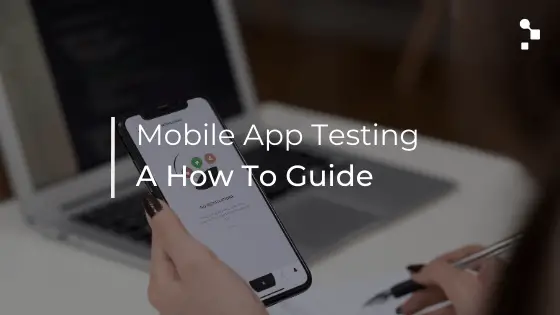The combined Google Play Store and Apple App Store regularly have 4.52 million apps available, and the Windows and Amazon app stores each have an additional 1.1 million apps.
While some apps are downloaded thousands of times, others sit in their respective stores untouched or barely used.
One of the primary reasons for this is the need for a better user experience. That is why app user testing is essential in the app development lifecycle.
This post discusses the significance of app user testing and the procedures for practical testing.
Why is App User Testing Essential?
A pre-launch app user test is an excellent approach to learning about and enhancing your product.
- It provides crucial insights on what works well with users and what doesn’t, assisting the developer in avoiding errors that might be fatal after launch.
- It validates all of your app’s assumptions.
- Assists you in launching an app that will be well-received.
- All mobile apps strive for increased user base and profitability.
- As a result, you want an app that consumers will buy, download, and utilize.
- This is where user testing should come in
Testing your mobile app thoroughly before launching is crucial to ensure a high-quality user experience and minimize the chances of critical issues or bugs affecting your users.
This article will explore the key steps and best practices to test your mobile app before its official release effectively.
Read Also: 13 Impacts of Blockchain Technology on the Future of Programming
How to test your mobile app before launching
1. Define clear testing objectives
Start by establishing clear testing objectives and goals for your mobile app. Consider functionality, performance, usability, security, and compatibility with various devices and operating systems.
Defining your objectives will help structure your testing efforts and ensure comprehensive coverage.
2. Create a test plan
Develop a comprehensive test plan outlining the scope, methodology, test cases, and resources. First, consider all possible scenarios and interactions within your app.
Then, divide your app into logical sections and determine which areas require more testing focus based on their criticality and complexity.
3. Functional testing
This type of testing ensures that your app functions correctly and meets the specified requirements. Test each feature and function of your app individually to verify its behavior and identify any functional defects.
Some standard applicable testing techniques include:
- Unit testing: Test individual units or components of your app to ensure they work correctly in isolation.
- Integration testing: Test the interaction between different app components to ensure they function seamlessly.
- User interface (UI) testing: Check the app’s interface for proper rendering, layout, responsiveness, and consistency across different devices and screen sizes.
- User experience (UX) testing: Evaluate the overall user experience, including ease of use, intuitiveness, and user satisfaction.
4. Performance testing
Performance testing assesses your app’s responsiveness, stability, scalability, and resource usage under various conditions. Some critical performance tests to consider are:
- Load testing: Test your app’s performance under expected user loads to ensure it can handle concurrent user activity.
- Stress testing: Push your app beyond its expected limits to identify performance bottlenecks and areas of improvement.
- Battery consumption testing: Measure your app’s impact on battery life to ensure it is optimized and does not drain excessive power.
- Network testing: Test your app’s behavior under different network conditions, such as 3G, 4G, and Wi-Fi, to ensure smooth functionality.
5. Usability testing
Usability testing evaluates how intuitive and user-friendly your app is. It helps identify potential user experience issues and gathers feedback to improve your app. Essential usability testing methods include:
- User surveys and interviews: Collect feedback from real users through surveys and interviews to understand their impressions and pain points.
- User observation: Observe users interacting with your app to identify usability issues, confusing workflows, or areas where users get stuck.
- A/B testing: Test different versions or variations of your app’s design and features to determine which ones provide a better user experience.
6. Compatibility testing
Ensure your app works seamlessly across different devices, operating systems, and screen sizes. Test your app on popular simulators/emulators to identify compatibility issues. Key areas to focus on include:
- Device compatibility: Test your app on various devices, including smartphones and tablets, to ensure consistent behavior and compatibility.
- Operating system compatibility: Test your app on different versions of the operating systems it supports to ensure it functions correctly.
- Screen size and resolution: Verify that your app’s UI adapts correctly to different screen sizes and resolutions without any layout issues.
Read Also: How to create a chatbot from scratch using AI
7. Security testing
Assess your app’s security measures to protect user data and ensure it complies with relevant security standards. Some basic security tests include:
- Data encryption: Test the encryption mechanisms to protect sensitive user information within the app and during data transmission.
- Authentication and authorization: Test the app’s login and authentication processes to ensure they are secure and protect against unauthorized access.
- Data validation: Check for vulnerabilities related to input validation and ensure that user inputs are appropriately validated to prevent security breaches.
- Session management: Test how the app handles user sessions, including session timeouts, persistence, and protection against session hijacking.
- API security: If your app interacts with external APIs, ensure that the API calls are secure and validate the data received from them.
8. Localization and internationalization testing
If your app targets a global audience, perform localization and internationalization testing to ensure it functions correctly in different languages, regions, and cultures—attention to text translations, date and time formats, currency symbols, and other localized elements.
9. Regression testing
As you make updates or bug fixes to your app, perform regression testing to ensure the changes have not affected existing features and functionalities. This helps prevent the reintroduction of previously resolved issues.
10. User acceptance testing (UAT)
Involve real users or a representative group of target users to perform UAT. They will test the app in real-world scenarios and provide feedback on its usability, functionality, and overall experience.
UAT helps identify any gaps between your app and user expectations.
11. Automated testing
Utilize automated testing tools and frameworks to streamline your testing process and improve efficiency. Automated tests can help with regression testing, performance testing, and repetitive tasks.
Use tools like Appium, Espresso, XCUITest, or XCTest for mobile app automation.
12. Bug tracking and reporting
Use a bug-tracking system to record and track all identified issues during testing. Document each bug with detailed steps to reproduce, expected behavior, and actual conduct.
This information will be helpful for developers to understand and fix the issues effectively.
13. Test on real devices
While emulators and simulators are valid for initial testing, testing your app on real devices is also essential.
Real devices can uncover device-specific issues and provide a more accurate representation of how your app performs in real-world conditions.
14. Continuous testing
Implement continuous testing practices throughout the development process.
This involves integrating testing into your development pipeline, running tests automatically with each code commit, and ensuring that new changes do not introduce regressions.
15. Gather user feedback
Encourage users to provide input through in-app feedback forms, ratings, reviews, or dedicated beta testing programs.
Collecting user feedback helps identify issues that may have been missed during testing and provides insights for future improvements.
Read Also: The rise of low-code and no-code programming: what it means for developers
16. Iterative testing and improvement
Testing should be an iterative process. Analyze the test results, prioritize and fix issues, and retest until you achieve the desired level of quality.
Continuous improvement based on feedback and testing results is critical to ensuring a successful app launch.
The essence of testing a mobile app before launching is to know what your app looks like, what experience it gives, what it feels like, and overall, to be sure it is ready to serve the public and serve its purpose.
If your software helps users reach their objectives, people will like it, use it again, and recommend it to others. As a result, you must understand how consumers engage with and utilize your app.

